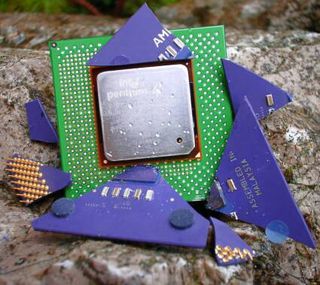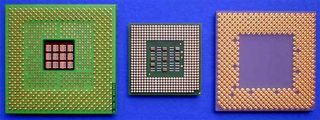Intel Beats AMD To 2 GHz
Pentium 4's Way Into The Market

When Intel launched its Pentium 4 processor in November 2000 the world wasn't quite sure what to think about this new 'net bursting' and 'rapid executing' CPU. Pentium 4's completely new architecture presented as many highlights as it showed shortcomings and the benchmarks revealed a rather inhomogeneous picture. While Intel's flagship was able to shine in some test applications, it looked pretty sad in others. Overall, it was utterly unable to completely outclass its No. 1 competitor, AMD's Athlon processor.
Pentium 4 Optimized Software
The most important features of Pentium 4's architecture are probably its 3.2 GB/s quad-pumped Front Side Bus , its Instruction Trace Cache , the Rapid Execution Engine and the SSE2-Instruction Engine . Each of those new features requires wisely optimized software to give Pentium 4 a real advantage. The fast processor bus wants to be fed and the trace cache as well as the rapid execution engine with its double-pumped ALUs and AGUs don't fair too well with current software. It goes without saying that SSE2 can only bite once software was at least compiled with a compiler that generates SSE2-instructions.
Intel is of course working hard on pushing software developers into implementing code optimizations for Pentium 4, but those guys don't feel particularly hard-pressed as long as the majority of users is using Pentium III or Athlon processors and only a small minority is owning Pentium 4 machines. Still, Pentium 4 enhancements are slowly finding their way into graphics chip drivers, games and professional applications, so that the future looks bright enough for P4.
Clock Speed Doesn't Just Sell Well
Pentium 4's maybe most important design feature is its high-speed architecture. The long execution pipeline allows core clocks that are far beyond the abilities of AMD's current Athlon-design. The high clock speeds don't mean that Pentium 4 is automatically faster than AMD's counterpart at lower clock speeds. Especially current software requires a much higher core clock of Pentium 4 to perform on par with AMD's Athlon processor. However, clock speed has long become the most important selling argument. The poorly informed average user assumes that a higher core clock translates into higher performance and that's where Pentium 4 beats Athlon hands down.
Today Intel introduces a Pentium 4 processor that runs at the incredible core clock of 2 GHz = 2000 MHz. That is most certainly an impressive number and it certainly signalizes Intel's clock speed lead over AMD. As you will see in the benchmarks however, at 2 GHz Pentium 4 finally manages to beat AMD's fastest processor, the Athlon 1400, in virtually any application.
What We Need Is More Than Just Speed
Well, speed is nice. However, not all of us are driving around in Porsches or Ferraris just because they are faster than other cars. First of all a processor has to be affordable. Intel has actually realized that and dropped Pentium 4 prices several times. I am of course not saying that Pentium 4 is actually cheap. I doubt that I will ever live to see Intel's processor pricing to be really attractive. What I do want to mention though is that Pentium 4 is not the super expensive microprocessor that it once was anymore.
Now the pricing of actual Pentium 4 processors is not quite telling the whole story. To run this CPU you require a motherboard and memory as well. This is where Pentium 4 lost another big round in terms of attractiveness. The so far only platform for Intel's flagship processor is based on Intel's i850 chipset. It makes the processor perform very well, but as an Intel chipset it is rather expensive, making P4-motherboards anything but bargains. To make matters worse, those motherboards require at least two pieces of the unpopular and overly expensive RDRAM memory. Once you sum up the price for processor, motherboard and memory you will see that Pentium 4 is not exactly an inexpensive solution. It is the predominant reason why Pentium 4 sales have been rather sluggish.
Stay on the Cutting Edge
Join the experts who read Tom's Hardware for the inside track on enthusiast PC tech news — and have for over 25 years. We'll send breaking news and in-depth reviews of CPUs, GPUs, AI, maker hardware and more straight to your inbox.
The Sense Or Nonsense Of High Speed Processors
There is another reason why the majority of people out there could and still can do just fine without 1.xx GHz processors. 99% of today's software performs just fine on Pentium III or Athlon systems with clock speeds of 1 GHz or even less. It is difficult to find a sensible justification for the purchase of a 1.4 GHz or faster system if there ain't any software that takes advantage of it. Even computer games, which used to be the No.1 clock speed eaters, are running perfectly on slower machines, especially once this system has been upgraded with a fast graphics card. This situation shows that the release of a processor at 2 GHz is pretty much the last thing we users really needed. The main catch of Intel's Pentium 4 2 GHz launch is that it improves Intel's prestige. Finally Intel can once again declare that it's making the doubtlessly fastest microprocessor. Intel hasn't been able to say that for a rather long time.
Improving Pentium 4's Attractiveness
Intel is obviously working on both of the above-mentioned issues why people might do just fine without Pentium 4. Moving the software industry towards more P4-enhancements and to software that really benefits from fast processors is a slow and meticulous process. Intel has legions of expensive 'processor enabling' engineers that 'help' software developers to program their applications the way Intel appreciates it. We will simply have to wait and see for the results.
What Intel can do however is to reduce the cost of Pentium 4 platforms. People don't like paying premiums for Rambus memory, especially not those royalties to a Rambus Inc. that is probably the most disliked company in the worlds PC hardware arena. So it took Intel only a small eternity until it finally came up with the i845 chipset . It teams up Pentium 4 with the much more attractive PC133 SDRAM memory, though removing a considerable amount of Pentium 4's performance. The PC133-version of i845 has still not been launched officially, but it is already available in the shops. There will also be another flavor of i845 that runs with DDR-SDRAM. This i845-version will allow much better performance than the current i845 with PC133 support. Intel claims it is delaying the release of the DDR i845 because of validation issues, others claim that Intel is tied to a late release of the DDR-i845 due to license agreements with our beloved Rambus Inc. I leave it up to you to decide what you want to believe. One thing is fact: i845 reduces the costs of Pentium 4 platforms significantly and that will help Pentium 4 sales. The average user who spots an inexpensive P4-box in a shop that says e.g. "1.7 GHz " won't know that it might be slower than a P4-system with 1.5 GHz processor only because the one is using i845 and the other is using i850.
VIA - Helping Or Spoiling?
The recent launch of VIA's P4X266 chipset has caused a lot of commotion within Intel. VIA's new and first Pentium 4 chipset supplies Intel's flagship CPU with the DDR-SDRAM support that Intel is deliberately holding back right now. Who cares if Intel ain't selling i845 with DDR-support as long as you can get a cheaper chipset WITH DDR-support from VIA? We as well as Intel know about VIA's plans for a Pentium 4 DDR chipset for more than half a year. Intel didn't expect that VIA would be fast enough to beat it to the release of i845 (PC133). What Intel certainly didn't anticipate though, is Wenchi Chen's gutsy move to simply release P4X266 without clearing the P4-bus license issues with Intel first.
Now in a way P4X266 clearly increases the attractiveness of Pentium 4 by a wide margin. Especially the performance-hungry ones of us with a dislike of Rambus were impatiently waiting for a DDR-platform for Pentium 4. From that point of view Intel should be pleased. OEMs have already stated a strong interest into VIA's new Pentium 4 chipset. Intel however remains the Moloch it has always been. It wants it all, the processor sales as well as the chipset sales. It might also NOT want DDR-systems for Pentium 4 out now. So we will see what is going to happen. Right now Taiwanese board makers are afraid of Intel's threat to punish them for producing P4X266 motherboards. My recent editorial is already covering this sad situation. VIA will have to see if Intel will sue it and get an injunction. NVIDIA is waiting for the outcome of that battle as well, because once Intel loosens its grip on the P4-bus license NVIDIA could release an nForce chipset for Pentium 4 as well.
Pentium 4 Gets A New Socket
Today Intel is also introducing the new µPGA Socket478 for the latest and future Pentium 4 processors. The new packaging is much smaller than the previous Socket423, but it comes with 55 more pins.


The above picture shows a comparison of the new Pentium 4 form factor in the middle between the Socket423 Pentium 4 on the left and AMD's Athlon processor on the right. The Pentium 4 processors at 1.9 and 2 GHz that are released today will ship in both socket versions, while the slower Pentium 4 CPUs will remain as Socket423 versions for the time being. Future Pentium 4 processors will only use the new µPGA Socket478 and Socket423 will finally disappear. We expect that there will be Socket478-to-Socket423 converters available that should give current Socket423 motherboards a prolonged life span.
Current page: Pentium 4's Way Into The Market
Next Page Pentium 4 Gets A New Socket. ContinuedMost Popular

